As a blogger, it’s tempting to only show you my successes: things that turn out perfectly, and look beautiful.* But that’s not fair to you, or me: it creates an unrealistic expectation of life, and how well you think you should do at any given project. As a reader, I get frustrated with blogs that are only about perfection and glamour: I find myself comparing myself, and feeling insufficient, but I also find myself bored, because while you can definitely learn from seeing other people’s amazing successes, I think you often learn a lot more from seeing their mistakes (for one thing, you learn how to avoid them!).
So this, dear readers, is a post about a sewing project for my Fortnight in 1916 that has most definitely not been a success – but which I have learned a great deal from, and which you may also learn something from!
I’ve showed you my black and white 1916 longline corset, and mentioned that it was made directly from a pattern, without being altered to fit me, so that it acted like a ready-to-wear corset, which is what most New Zealand women were wearing in 1916.
Here is the ironic part: it has turned out to fit me almost perfectly, and is extremely comfortable.
The custom-fitted corset I made? Not so much. Here is what it looks like after one wear:
(ergh is a perfectly reasonable response here).
Here is the stupid and hubris-filled parts:
Yes, the corset pattern was custom-fitted, in that I made it for myself. Seven years ago. When I was just a teeny bit slimmer.
And by a teeny bit, I mean 3 inches in the hips. But no problem, right? I’ll just leave a lacing gap, because it was designed without one.
And the corset itself was cut and started over three years ago, and then got abandoned for various reasons. When I started seriously planning for the Fortnight in 1916, it seemed like a perfect excuse to pull it out and finish it.
As I finished it, I realised that the reason I’d abandoned it was because of poor fabric choice: The damask is pretty, but too weak, and soils easily. “Oh well” I thought “It’s only two weeks: 7 wears…if it dies at the end, at least I will have finished it.”
So, I finished it, and because I wasn’t too fussed with it, I boned it in cable ties. To give the fabric some extra support, I put in a nice, firm waist-stay.
As it was my ‘comfortable’ ‘properly-fitted’ corset, I chose to wear it on laundry day for the first time. It wasn’t bad when I put it on in the morning, and wasn’t bad for doing laundry: the corset actually provided very nice back support for all the scrubbing and lifting and carrying. I did, as mentioned, pull a weird muscle around my collarbone hanging laundry on the line, but I’m not sure that was the corset’s fault.
So, all in all, for most of the day, the corset wasn’t an issue. Snugger than the black and white one, but not painful.
And then I got in the car to drive to teach my evening lesson, and less than three minutes down the road, I knew I was in trouble. There was a very odd pinching sensation at my waist, and the corset was lifting and pushing up under my rib-cage. I could breath, but it wasn’t fun, and no matter what position I sat in, I could not get comfortable. I knew that something was wrong, but couldn’t do anything about it.
As soon as I parked and got out of the car for class I was alright, and I focused on teaching and managed to compose myself and be fine. But the ride home was also a nightmare, and as soon as I got home I divested myself of my layers and ripped the corset off, to discover livid red-purple marks across the sides of my waist. I have creases with the black and white corset, and with other corsets, but I’ve never had marks like this before.
The corset itself was in terrible condition.
The busk had ripped out of one side of the front (apparently when I started it three years ago I flat lined everything except the front busk area – why I did this I don’t know, but I can’t believe I was that stupid!):
And the cable ties had warped and bent:
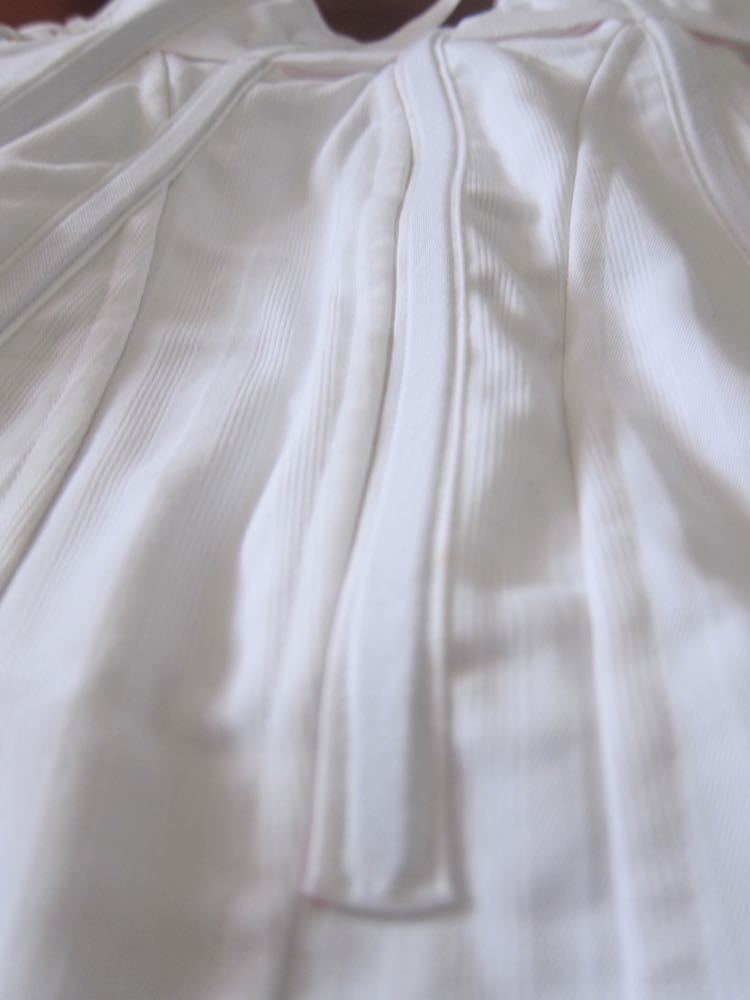 And all in all, it did not look spiffy.
And all in all, it did not look spiffy.
Neither did I when I inspected myself after my sponge-bath the next morning. (please excuse my cold, purple, extremely unflattering skin):
It doesn’t look too bad in the photos, but those are essentially blood blisters: welts under the skin from the corset. I’ve worn many corsets that reduced my waist significantly more than that one, but I’ve never had marks from the corset over 12 hours after taking it off (and, three days later, they are still there).
As far as I can figure out, what happened in the car is that the corset busk and bones were a little too long, and when I sat down, they tried to shift up, but couldn’t, because the waist stay held the corset so snuggly at my waist. So the corset held on to my waist skin, and lifted that up and my waist + corset ended up shoved under my ribcage.
So what can we take from this:
The poor choice of fabric, and my change in size over time were things I knew were a problem, but which I hubristically** ignored, because I didn’t want to deal with the work of fixing them.
I’m definitely going to be re-thinking the use of cable ties for 1910s corsets in the future – every example of a longline corset in NZ is boned with metal, and I think that plastic, while it’s better at imitating whalebone in many ways, simply doesn’t hold up enough with extensive wear. I’m going to try a corset with German plastic boning, and see if that does better. (yay, research!).
I’m also going to test-drive (literally) corsets before committing to a car ride in future. Best to know ahead of time that anything over 5 minutes is torture!
I’m almost pleased with the rip at the front busk, because at least two of the extent 1910s corsets in NZ show mends in exactly this area. Mine happened too quickly, because the fabric was insufficient, but even with strong fabric, if you’re really doing work in a corset (laundry!), it’s a weak spot.
So, I am now down to one corset for the duration of my fortnight, but I also learned quite a bit about corsetmaking and wearing, and learning was the intention of the fortnight, so I have no regrets there.
I’m down to one corset, but I can get by just fine with one for two weeks. Lying in bed the night of the incident, I thought of the 1916 woman I was representing, and what it would have mean to her if her corset had turned out to be hideously painful to wear.
During the war a corset was (for most women), a necessity, but also a significant monetary outlay. So if you bought one that felt alright in the shop, and for the first few hours, but turned out to be very uncomfortable, and to even cause welts, there is nothing you could do. We live in an era of such wealth, and easy disposability and replaceability. But for so many women, a mistake like that would have been days of chaffing and discomfort.
* It’s also tempting to never admit to mistakes on the internet, because as soon as you do people assume you are bloody stupid and point out the most basic stuff to you. I try to breath and think of it as a public service: if someone is that desperate to be right they must need a lot of reassurance 😉
** A moment of celebration for the fact that this is, indeed, a real word.

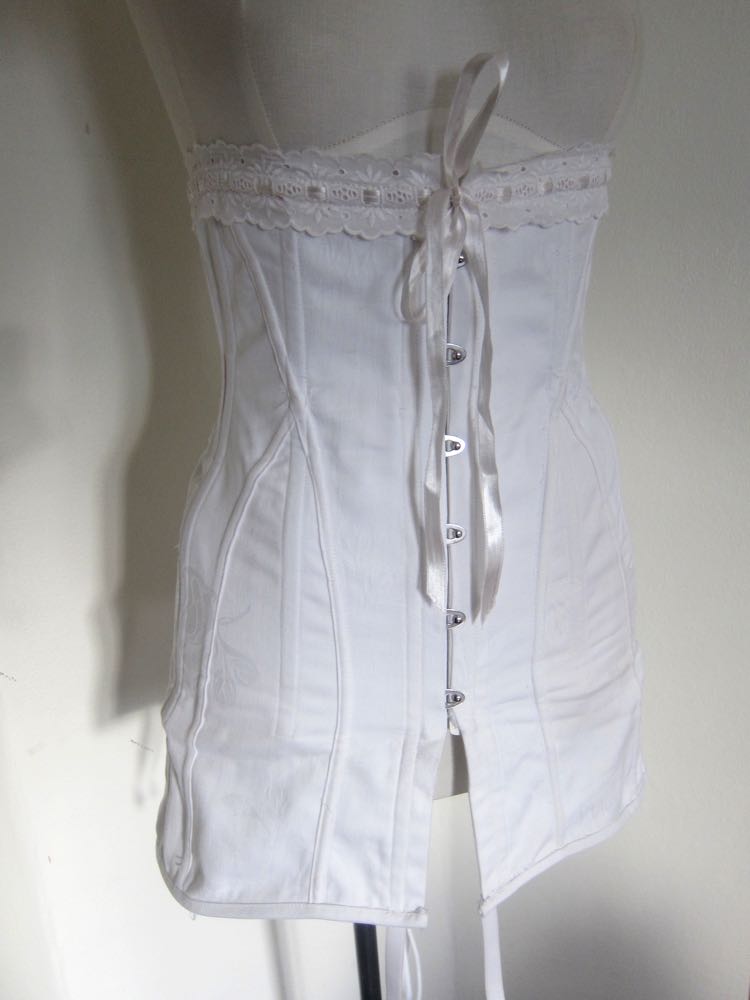
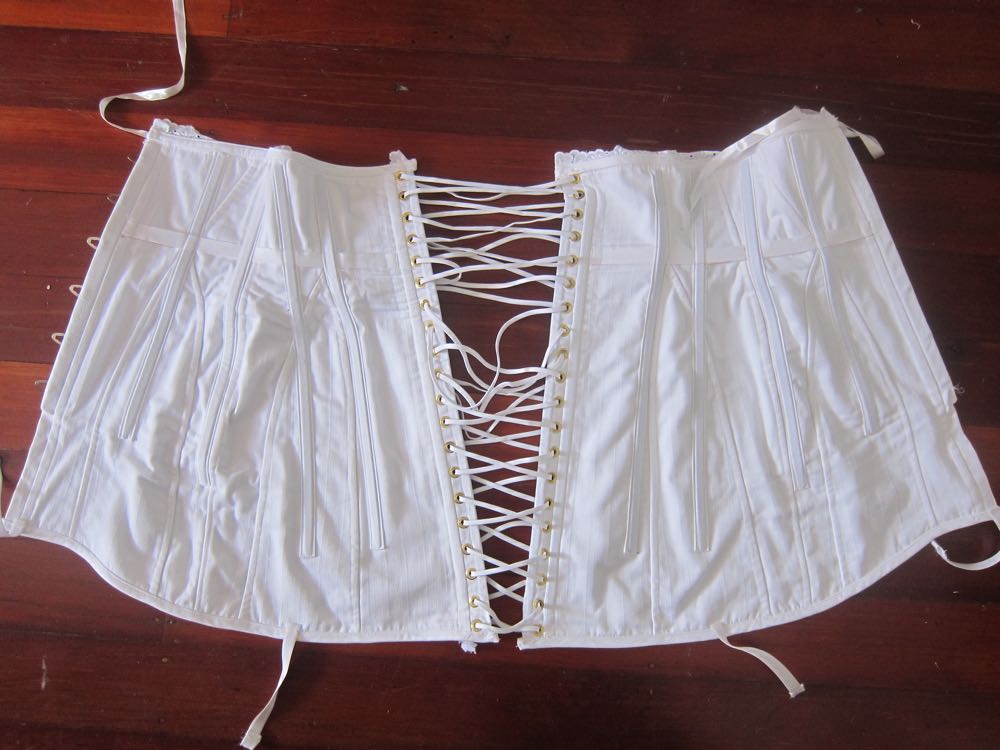
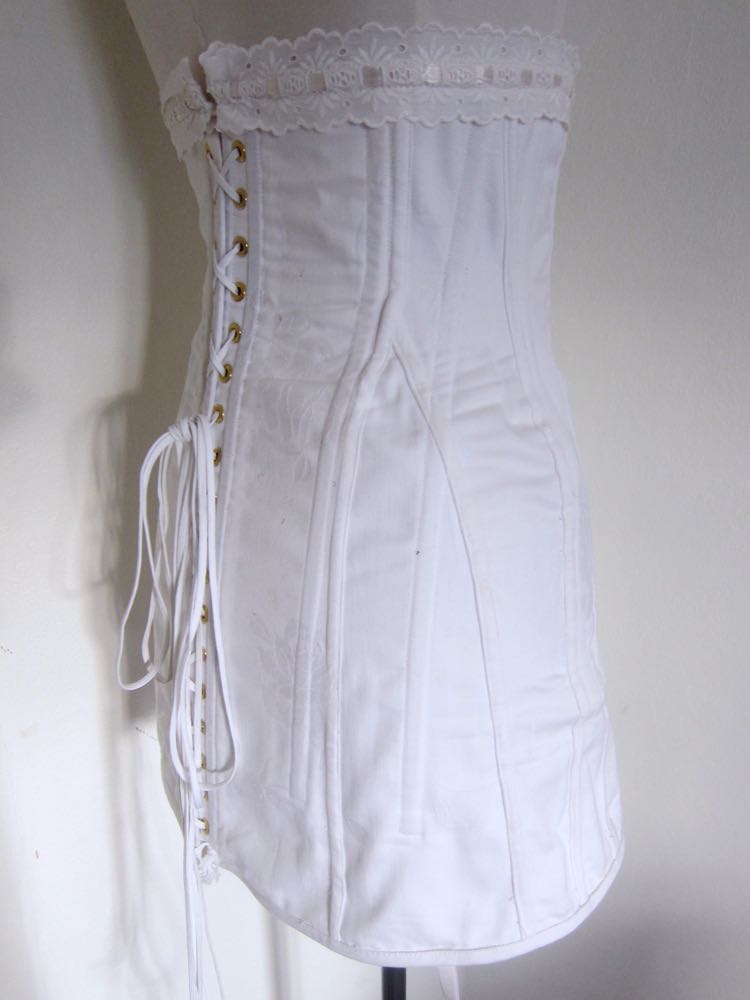
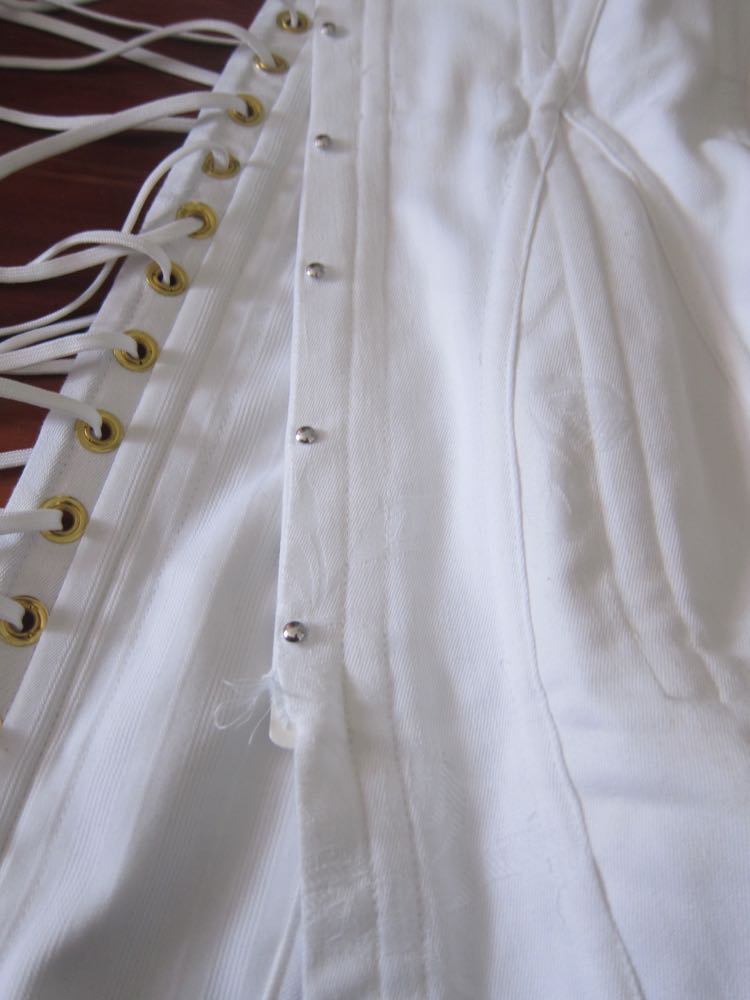


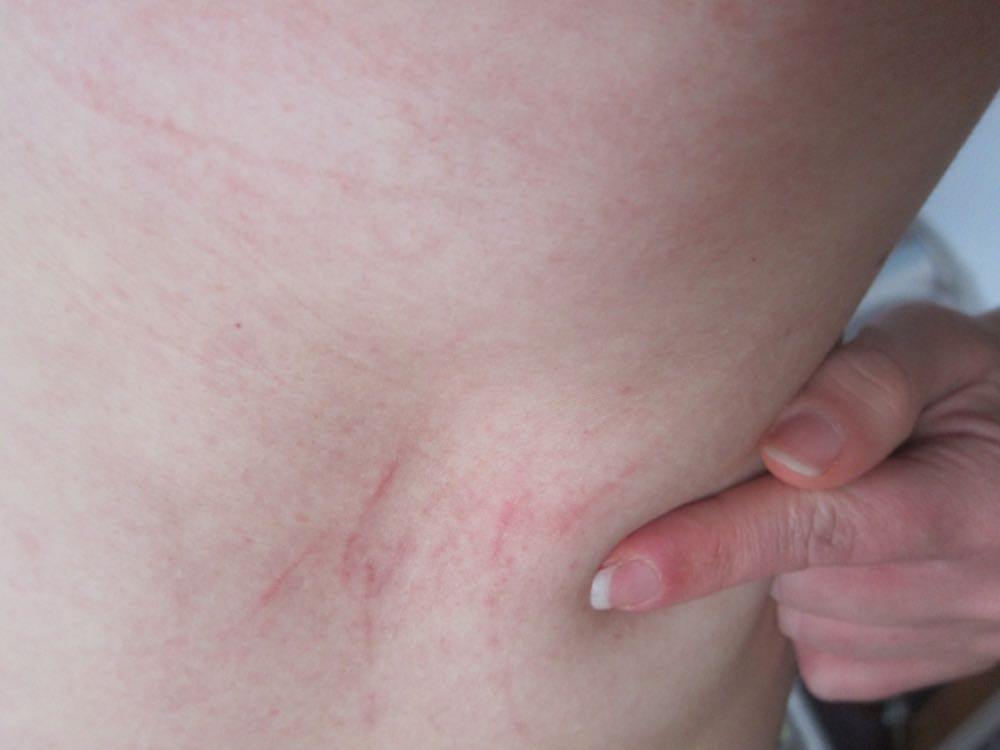

My 1910s corset has a few bones that are a bit long in the front so they poke into my legs when I sit. Not good for long car rides either. I remembered to check the length of the back bones when making my mock up but forgot about the front ones…
My worst painful costuming experience was actually due to my stockings! My stockings got a huge run right before Costume College one year, so I just ran out to the store and grabbed a fresh pair of modern nude thigh highs from the mall, but I accidentally grabbed a size down. I didn’t notice until I had been wearing them for 8 hours and I had some awful marks from those plastic grippy bits that are supposed to help them defy gravity. 🙁
Ouch! It hurts only watching your pictures! Well, lesson learn: don’t drive and wear a 1910 corset! What type of car do you have: shift or automatic?
You are being far far too hard on yourself. I don’t know much about corset construction but I’m thinking that metal might have punctured you rather than (just) abrading you.
Tell mw – have you been hoarding your Sunlight soap because it isn’t sold in NZ? I could get you some. Also, I’m pretty sure I could get you a wash board. There are serious chunks of Canada without electricity to this day and many of us have used the old Sunlight and a washboard to do our laundry and then, if its summer, spread it over bushes or rocks. Ah, happy days! Mind you, I was only washing my clothes and my sleeping bag liner, not duvet covers.
Don’t pay any attention to people who say rude things to you. THEY aren’t trying the experiment, which is bound to have its pitfalls.
Susan
I camped in Canada with Sunlight soap, too! With the Guides! For this American, it was a real shocker to see bar laundry soap, but really makes a lot of sense.
As a feminist and fellow human being, it’s astounding what people believe they should say online, where no one can contradict them, and they can scuttle back into their miserable day-lives. It affects women more than men. And while it usually takes a million nice things to erase the feeling of bad things, let me add to that million:
Your blog is lovely. You bring joy and artistry to your creations along with your historicism. I don’t have time for much “fun” internet reading, and your blog is my stop. You stand up for neat causes. This project is neat because it reminds me of the work of my favorite history-educator, Lucy Worsely, who tries to make her displays immersive and to try to bring down barriers to a love of history and place. Besides, this is a historic costuming blog, not Pinterest, so aspirational perfection is not required. In fact, it’s better to be real.
Elise, you echoed my thoughts…this blog is my refuge. Leimomi provides an example of intellectualism combined with the grace and joy of being thoroughly human. That she does this in the context of historical clothing is an added bonus. Members of this blog echo her strong and quiet voice by polite behaviour not often seen ‘on line’. So, thank you all for being here and for cherishing this very special place.
Thank you! That is the best possible commendation this blog could receive!
I’m so glad that we are blog-friends, Lyn!
Dear, that looks terrible! Good lesson though, as painful experiences often are. I’ve made do with corsets that I’ve really outgrown before cutting them out and finishing them, because I was too lacy to adjust them. Not very comfortable, but I’ve never had such a ghastly result as this… I suppose chafing stays and corsets might have been a common thing back when most women bought them ready made or even second hand.
Like a modern long-line bra…damn near impossible to find one that fits!
I am really enjoying this series and find this completely fascinating. One thing I would love to know is how women took care of themselves during menstruation. Of course, if it is a topic you don’t want to address, I understand. Thanks for sharing your experiences with us, good and bad.
I will actually be blogging about that, but it might take a while as there is SO MUCH I need to talk about from this experiment.
I bet that this experiment could result in a whole year’s blog posts!
Menstruation would be interesting to read about, as would issues relating to pregnancy, childbirth, and breastfeeding with long-ling corsets! Also in the realm of Rablais, what about toileting in general? Still 2 years after childbirth, I still pee my pants from time to time–something that many many many other women also experience–so sometimes wear a menstrual pad.
Being interested in such information puts you in a funny spot, though: How much do you feel like sharing? At this point, this veers to being a post about costuming AND about very private aspects of your body–even if you don’t talk about yourself specifically.
So yes, I want to know how that would work, but not enough to put your bodily autonomy on the line….rather “on line”. (trying to make a pun to make a very serious topic about women’s ownership of their bodies on the internet end with a funny)
Ouch, that really looks painful. But it’s a good lesson, also for your readers. I plan on making a teens corset this year. After seeing these pictures, I will definitely keep in mind to check the boning length and strenghten the front edge! So, thank you for showing us your mistakes. It really is a great help! And your other corset, the black and white one, turned out so lovely, it is a definite succes.
Thank you! So glad this was helpful!
A thought: Your injury came about because you had to do something in the damask corset that a 1910s housewife wouldn’t have done–namely, drive a modern car. If you hadn’t had to drive that day, you wouldn’t have been injured by it or even suffered much discomfort.
That is absolutely true. It still definitely isn’t as comfortable as the other one – particularly for sitting in, which would have impacted on any woman working as a seamstress, ‘typewriter’, ambulance driver etc. at the period.
The pull to my shoulder/collarbone was from doing a historical activity though (hanging the laundry), and the rip to the front of the corset is interesting and historical, because it’s exactly the damage you see in some period longline corsets.
Ouch, I hate seeing those bruises……sympathy pains! I’m trying to figure out….it was sitting with your arms out steering? And perhaps legs moving to drive? Anyway so sorry you were hurt, even in such a good cause.
ceci
Thanks for the sympathy! It’s because of the position modern cars put your body in – the seats are slanted up, so that your legs are raised, shoving a corset up into your ribcage.
Ouch! That looks really nasty.
It does look like the cable ties are part of the problem. My experience of plastic boning is that it bends out of shape due to body heat, and then doesn’t regain its former shape, so it ends up with weird uncomfortable kinks in it. I doubt steel bones would have been any more comfortable for driving in though, that corset is just not compatible with the 21st century automobile.
sewcharacteristicallyyou.comI thank you for your honesty in sharing this. I know I need to hear that other people make sewing mistakes just like I do! I also want to be humble enough to share about my own mistakes so that others don’t repeat them, although if the are like me, they will probably have to learn by doing. 🙂
Sarah
http://www.sewcharacteristicallyyou.com/blog
I appreciate your honesty. I too have felt the urge to quit when I’ve read someone’s perfect blog about their perfect outfit on their perfect outing with their perfect group and been discouraged. You want to read about success AND failures. Because you want to believe that if THEY fail and succeed, you can fail and succeed too. Being please with the modest successes is good too. It shows the reader that they can and should look for their own modest successes as well.
Thank you! That’s a beautiful way to put it.
I’m honestly enthralled reading your detailed accounts of your misadventure with this corset – it includes so much good advice and lessons learned! I accidentally made this corset with the busk and front bones slightly too long but I did use a spiral boning which made sitting much easier! Not as firm as my steel boned corsets, but I recommend re-trying this one with the spiral bones.
I had a similar experience with a long 1910’s corset during a long train ride, which is definitely something that most women would have done in them. It was made after an authentic pattern, not adapted to my figure, and the whole thing sort of slid upwards gradually, putting more and more pressure on my lower ribs. It hurt, a lot, especially towards the end of the 4-hour journey. I have since switched out most of the steel bones in it for wide cable ties. That helped, it’s much more comfortable now, but I did also shorten the bones a bit. I don’t like that corset very much, though, and at some point I will have to make a new one. I think I’ll look around for examples of different 1910’s models and make a custom pattern.
It was such a pleasure meeting you at Coco 2016! I have read your blog for years, so it was a real treat to finally meet you! Your stories and experiences shared regarding your 1916 Fortnight experiment was simply fascinating! I enjoyed it very much indeed!
Dear Leilomi, I have been a lurker at your site for a longtime now, I too live in NZ and enjoy sewing, and very much enjoy and respect your blog for its common sense, your pleasure in what you do, and attention to accuracy and detail.
One of the other comments mentions that some aspect of the corset injury may be attributed to the fact that you were doing something a 1916 woman would not normally have done, (driving a car) and that made me think about your collarbone injury from hanging out the washing. I am not sure what type of clothesline you have, but you mention “reaching up” to hang out the clothes.My Nana, who had six kids, and was the first woman in her street to get an electric washing machine, had the sort of clothesline that consisted of a wooden T-shape stuck into the ground at either end, and wires (or rope) forming lines in between (looked quite a lot like a section of above ground power lines). There was a removable stick in the middle, which you took out to lower the line in order to peg the clothes on, then stuck back in to hoist the washing line up higher to keep the sheets of the ground and enable the washing to benefit from any breezes etc. So it may be that women of an earlier era would not had had to reach up too much to hang the washing out. Just one more thing to consider.
I live in a little country town in the Bay of Plenty where even in 2016 eccentricity is still looked at sideways so I am quite envious of your ability to do so much costuming and re-enactment in cosmopolitan Wellington!
Thanks for commenting! Good to hear from a lurker – hope this inspires you to join in more discussions.
Based on my research, the type of clothesline you describe was very unusual, if not entirely unknown, in 1916. Every mention or illustration I can find shows lines strung between poles, at much the same height as my line – just high enough to keep the sheets from dragging when wet. Washing powder ads frequently depicting women hanging the laundry, so there are far more illustrations than you’d expect. So I’d say that the height of my clothesline was absolutely accurate as the most common style and general height in 1916.
Very quickly, here is a sample illustration from 1916: https://paperspast.natlib.govt.nz/newspapers/MT19160705.2.51.1?query=blue%20monday